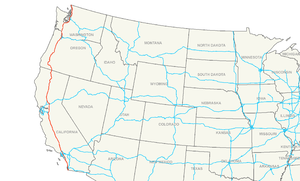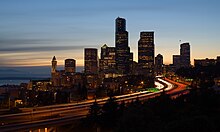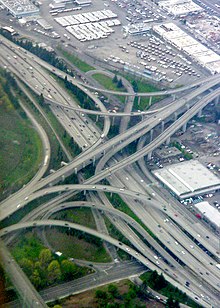Interstate 5: Difference between revisions
mNo edit summary |
No edit summary |
||
| Line 15: | Line 15: | ||
}} |
}} |
||
'''Interstate 5''' (I-5) is the main [[Interstate Highway System|Interstate Highway]] on the [[West Coast of the United States]], paralleling the [[Pacific Ocean]] from [[Canada]] to [[Mexico]] ([[Washington]] to southernmost [[California]]) and serving some of the largest cities of that part of the U.S., including [[Seattle]], [[Tacoma]], [[Portland, Oregon|Portland]], [[Sacramento]], [[San Francisco]]/[[Oakland]], [[Los Angeles]], and [[San Diego]]. It links the state capital cities of Washington, Oregon, and California. Its southern terminus is at the [[United States - Mexico border]]. Its northern terminus is at the [[Canada-United States border]]. Interstate 5 is the only Interstate Highway to touch both the [[Canada|Canadian]] and [[Mexico|Mexican]] borders, though others come close to this, such as Interstate 35 in the Central region of the US. At its southern end, I-5 continues into [[Tijuana]], Mexico, as the [[Mexico Federal Highway 1]]. On its northern end, I-5 continues into [[Vancouver]], Canada, as the [[British Columbia Highway 99]]. |
'''Interstate 5''' (I-5) is the main [[Interstate Highway System|Interstate Highway]] on the [[West Coast of the United States]], paralleling the [[Pacific Ocean]] from [[Canada]] to [[Mexico]] ([[Washington]] to southernmost [[California]]) and serving some of the largest cities of that part of the U.S., including [[Seattle]], [[Tacoma]], [[Portland, Oregon|Portland]], [[Sacramento]], [[San Francisco]]/[[Oakland]], [[Los Angeles]], and [[San Diego]]. It links the state capital cities of Washington, Oregon, and California. Its southern terminus is at the [[United States - Mexico border]]. Its northern terminus is at the [[Canada-United States border]]. Interstate 5 is the only Interstate Highway to touch both the [[Canada|Canadian]] and [[Mexico|Mexican]] borders, though others come close to this, such as Interstate 35 in the Central region of the US. At its southern end, I-5 continues into [[Tijuana]], Mexico, as the [[Mexico Federal Highway 1]]. On its northern end, I-5 continues into [[Vancouver]], [[British Columbia]], Canada, as the [[British Columbia Highway 99]]. |
||
This highway links to [[control cities]] in [[California]] ([[San Diego, California|San Diego]], [[Los Angeles, California|Los Angeles]], [[San Francisco, California|San Francisco]], [[Sacramento, California|Sacramento]], and [[Redding, California|Redding]]), [[Oregon]] ([[Medford, Oregon|Medford]], [[Eugene, Oregon|Eugene]], [[Salem, Oregon|Salem]], and [[Portland, Oregon|Portland]]), and [[Washington]] ([[Tacoma, Washington|Tacoma]], [[Seattle, Washington|Seattle]], [[Everett, Washington|Everett]], [[Mount Vernon, Washington|Mount Vernon]], [[Bellingham, Washington|Bellingham]]). [[Vancouver]], [[British Columbia]] (signed as "Vancouver B.C." to avoid confusion with [[Vancouver, Washington]], which is in the opposite direction) is also a control city on Interstate 5 from the Seattle-Tacoma area to the northern terminus at the Canadian border. |
This highway links to [[control cities]] in [[California]] ([[San Diego, California|San Diego]], [[Los Angeles, California|Los Angeles]], [[San Francisco, California|San Francisco]], [[Sacramento, California|Sacramento]], and [[Redding, California|Redding]]), [[Oregon]] ([[Medford, Oregon|Medford]], [[Eugene, Oregon|Eugene]], [[Salem, Oregon|Salem]], and [[Portland, Oregon|Portland]]), and [[Washington]] ([[Tacoma, Washington|Tacoma]], [[Seattle, Washington|Seattle]], [[Everett, Washington|Everett]], [[Mount Vernon, Washington|Mount Vernon]], [[Bellingham, Washington|Bellingham]]). [[Vancouver]], [[British Columbia]] (signed as "Vancouver B.C." to avoid confusion with [[Vancouver, Washington]], which is in the opposite direction) is also a control city on Interstate 5 from the Seattle-Tacoma area to the northern terminus at the Canadian border. |
||
Revision as of 21:27, 23 March 2009
 | |
| Route information | |
|---|---|
| Length | 1,381.29 mi[1] (2,222.97 km) |
| Existed | 1957[citation needed]–present |
| Major junctions | |
| South end | File:Mexico Federal Highway 1.svg MX 1 at Mexican border in San Ysidro, CA |
| North end | |
Interstate 5 (I-5) is the main Interstate Highway on the West Coast of the United States, paralleling the Pacific Ocean from Canada to Mexico (Washington to southernmost California) and serving some of the largest cities of that part of the U.S., including Seattle, Tacoma, Portland, Sacramento, San Francisco/Oakland, Los Angeles, and San Diego. It links the state capital cities of Washington, Oregon, and California. Its southern terminus is at the United States - Mexico border. Its northern terminus is at the Canada-United States border. Interstate 5 is the only Interstate Highway to touch both the Canadian and Mexican borders, though others come close to this, such as Interstate 35 in the Central region of the US. At its southern end, I-5 continues into Tijuana, Mexico, as the Mexico Federal Highway 1. On its northern end, I-5 continues into Vancouver, British Columbia, Canada, as the British Columbia Highway 99.
This highway links to control cities in California (San Diego, Los Angeles, San Francisco, Sacramento, and Redding), Oregon (Medford, Eugene, Salem, and Portland), and Washington (Tacoma, Seattle, Everett, Mount Vernon, Bellingham). Vancouver, British Columbia (signed as "Vancouver B.C." to avoid confusion with Vancouver, Washington, which is in the opposite direction) is also a control city on Interstate 5 from the Seattle-Tacoma area to the northern terminus at the Canadian border.
Notably, a control city not directly linked by this highway is San Francisco, which is about 80 miles (130 km) west of I-5. To the south, Interstate 580 splits from I-5 towards San Francisco, while, to the north, Interstate 505 cuts south to Interstate 80, which serves that city. That routing, via I-580, I-80 and I-505, was once Interstate 5W.[citation needed]
Route description
| mi[1] | km | |
|---|---|---|
| CA | 796.53 | 1281.89 |
| OR | 308.14 | 495.90 |
| WA | 276.62 | 445.18 |
| Total | 1381.29 | 2222.97 |
| Major cities Bolded cities are officially-designated control cities for signs |
|---|
|
California
The most southerly point of Interstate 5 is at the United States-Mexico border at the San Ysidro border crossing, one of the busiest in the world.[2] Beginning at the border in San Ysidro, which is part of the city of San Diego, as the John J. Montgomery Freeway, I-5 goes through the suburbs of National City and Chula Vista before reaching downtown San Diego. It then parallels the Pacific coastline, going through the northern suburbs of San Diego, bisecting the University of California, San Diego campus, and passing the I-805 merge, before passing through the 28 miles (45 km) of Marine Corps Base Camp Pendleton in northern San Diego County. Here I-5 is also known as the San Diego Freeway. I-5 covers 797 miles (1,283 km) in California.
At Dana Point, I-5 turns inland and heads due north through Mission Viejo to the El Toro Y interchange in southeastern Irvine. I-5 becomes the Santa Ana Freeway as it runs southeast to northwest, passing through major cities and suburbs in Orange and Southern Los Angeles counties. Southern Californians refer to it as "the 5" or as the Santa Ana Freeway in the Los Angeles area. From this point, the San Diego Freeway continues northward as I-405.
When the freeway reaches the East Los Angeles Interchange one mile (1.6 km) east of downtown Los Angeles, I-5 becomes the Golden State Freeway. The route continues through the San Fernando Valley and then crosses the Newhall Pass through the Santa Susana Mountains into the Santa Clarita Valley. For about a four-mile (6 km) stretch between Santa Clarita Valley and the Pyramid Lake, the northbound and southbound lanes separate and actually invert, with the southbound lanes being to the east of the northbound ones. Beginning at that point, the Golden State Freeway sharply rises to the north through the Grapevine to eventually reach the second-highest point of its entire length, the Tejon Pass (elevation 4,183 ft (1,275 m). (1,275 m)) through the Tehachapi Mountains. Path 26 power lines generally parallel the freeway along this stretch. The freeway then sharply descends for 12 miles (19 km) at Tejon Pass to around Template:Ft to m at Grapevine near the southernmost point of the San Joaquin Valley, approximately Template:Mi to km south of Bakersfield and Template:Mi to km south from where State Route 99 splits away from it in Wheeler Ridge.

From Highway 99 to south of Tracy, I-5 skirts along the far more remote western edge of the great Central Valley, and thus here is removed from population centers such as Bakersfield and Fresno with other state highways providing connections. Interstate 580 splits off from I-5 at a point south of Tracy, providing a loop-route connection to the San Francisco Bay Area. After passing Tracy, I-5 heads north through Stockton and Sacramento before turning west to Woodland. At Woodland, the interstate heads northwest again towards Dunnigan, where it converges with Interstate 505.
From Dunnigan, I-5 skirts north along the western edge of the Sacramento Valley to Red Bluff. I-5 then enters the Shasta Cascade region, passing through Redding and Shasta Lake before climbing up to near the foot of Mount Shasta. The interstate then travels to Weed and Yreka before reaching the Oregon border.
Oregon
About Template:Mi to km north of the California border, the highway crosses Template:Ft to m Siskiyou Summit, the highest point on I-5. Dropping down into Rogue River valley through Oregon's southern mountains and towns such as Ashland, Medford and Grants Pass. Turning north across three passes to the Umpqua Valley and through Roseburg, the mountains tend to turn into hills, and as it reaches Cottage Grove, the road enters the Willamette River Valley. At Eugene the highway intersects with the short Interstate 105. The interstate then heads almost due north, skirting Albany and Corvallis, and passes through Salem. There were plans to build a spur, called Interstate 305, into Salem. I-5 covers 308 miles (496 km) in Oregon.

Just north of Salem, between mile marks 259 and 260, placed in the median is a sign where the 45th parallel crosses I-5. It bears the words "45 Parallel half way between the Equator and the North Pole".
The highway then tracks a little to the northeast, Interstate 205 splits off south of the Portland metro area. From here it passes up through Tualatin and Tigard along former U.S. Route 99W before hitting the southern terminus of I-405 and the Marquam Bridge. Also planned was a spur in Portland off I-405, called Interstate 505, but it was never built and has been removed from city plans. A stub of I-505 exists as a long exit ramp to U.S. Route 30.
After crossing the Willamette River on the Marquam Bridge, I-5 has junctions at the western terminus of Interstate 84 and the northern terminus of I-405. It then continues through the northern parts of the city of Portland, and crosses into Washington via the Interstate Bridge.


Washington
The highway begins in Washington over the Columbia River and drops down into the city of Vancouver. About seven miles (11 km) into the state, it reaches the northern terminus of I-205, which is on the eastern edge of the Portland-Vancouver metropolitan area. It then tracks north by northwest to Kelso and Longview, at which point it ceases paralleling a large bend of the Columbia. Continuing north through the Willapa Hills, the freeway eventually reaches Olympia, where it bends sharply east, after that it goes through Fort Lewis and by McChord AFB, then finally Tacoma where it bends sharply north again to reach Seattle. The Ship Canal Bridge carries it over Portage Bay in Seattle. The freeway makes its way out of the Seattle/Tacoma/Everett metro area, crosses the floodplains of three rivers, through the Skagit Valley and the Mount Vernon-Anacortes Metropolitan Area to the northern city of Bellingham to arrive at the Peace Arch Canadian border crossing between Blaine, Washington, and Surrey, British Columbia. Highway 99 continues northwesterly from the border into Vancouver, B.C. I-5 covers 277 miles (446 km) in Washington.
History
An extensive section of this highway (over 600 miles (970 km)), from approximately Stockton, California, to Portland, Oregon, follows very closely the track of the Siskiyou Trail.[3] The Siskiyou Trail was based on an ancient network of Native American footpaths connecting the Pacific Northwest with California's Central Valley. By the 1820s, trappers from the Hudson's Bay Company were the first non-Native Americans to use the route of today's I-5 to move between today's Washington State and California. During the second half of the 19th century, mule trains, stagecoaches, and the Central Pacific railroad also followed the route of the Siskiyou Trail.[3] By the early 20th century, pioneering automobile roads were built along the path of the Siskiyou Trail, notably the Pacific Highway. The Pacific Highway ran from British Columbia to San Diego, California, and was the immediate predecessor of much of U.S. Route 99. The route of U.S. 99 was in turn used as a basis for much of the route of today's I-5.
Major intersections

- Interstate 805 (bypass) in south San Diego, California [Exit 1A]
- Interstate 15 in San Diego, California (future; this freeway is currently signed as State Route 15) [Exit 13A]
- Interstate 8 in San Diego, California [Exit 20]
- Interstate 805 (bypass) in north San Diego, California [Exit 31]
- Interstate 405 (bypass) at the El Toro Y in Irvine, California [Exit 94A]
- Interstate 605 in Santa Fe Springs, California [Exit 123]
- Interstate 710 southeast of downtown Los Angeles, California
- Interstate 10 at the East Los Angeles Interchange complex, east of downtown Los Angeles, California
- Interstate 405 (bypass) in Sylmar, California [Exit 158]
- Interstate 210 in Sylmar, California [Exit 161A]
- Interstate 580 south of Tracy, California
- Interstate 205 northeast of Tracy, California
- Interstate 305 in Sacramento, California (hidden, known as Capital City Freeway.) [Exit 518]
- Interstate 80 in Sacramento, California [Exit 522]
- Interstate 505 in Dunnigan, California
- Interstate 105 in Eugene, Oregon [Exits 194A and 194B]
- Interstate 205 (bypass) in Tualatin, Oregon (southern junction) [Exit 288]
- Interstate 405 (bypass) in Portland, Oregon (southern junction) [Exit 299B]
- Interstate 84 in Portland, Oregon [Exit 300B]
- Interstate 405 (bypass) in Portland, Oregon (northern junction) [Exit 302C]
- Interstate 205 (bypass) in Salmon Creek, Washington (northern junction) [Exit 7]
- Interstate 705 in Tacoma, Washington [Exit 133]
- Interstate 405 (bypass) in Tukwila, Washington (southern junction) [Exit 154A]
- Interstate 90 in Seattle, Washington [Exit 164B]
- Interstate 405 (bypass) in Lynnwood, Washington (northern junction) [Exit 182]
Auxiliary routes
- San Diego, California - I-805
- San Diego, California - I-905 (future)
- Los Angeles, California - I-105
- Los Angeles, California - I-605
- Los Angeles and Orange County, California - I-405
- Tracy, California - I-205
- Sacramento, California - I-305 (unsigned)
- Zamora, California - I-505
- Eugene, Oregon - I-105
- Portland, Oregon - I-405
- Portland, Oregon and Vancouver, Washington - I-205
- Tacoma, Washington - I-705
- Seattle, Washington - I-405
I-5 will have a complete set of auxiliary routes (105, 205, 305, 405, 505, 605, 705, 805, 905), with the completion of Interstate 905 in San Diego. Currently, Interstate 80 and Interstate 90 are the only two interstates to have complete sets of auxiliary routes, by the numbers.
References
- ^ a b "Route Log and Finder List: Table 1 - Interstate System". FHWA. Retrieved 2007-07-17.
- ^ Busiest border crossing
- ^ a b Museum of the Siskiyou Trail
